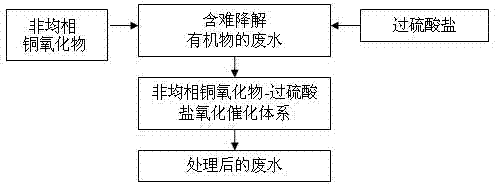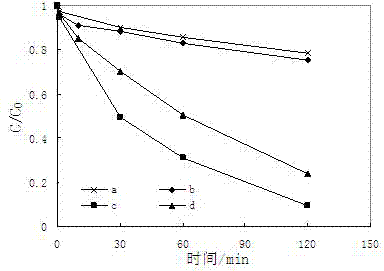Method for treating organic pollutants in water by catalyzing persulfate through heterogeneous copper oxide
A technology of organic pollutants and copper oxides, applied in the field of environmental pollution control, can solve problems such as complex technical processes, incomplete removal of organic pollutants, and difficult treatment, achieving high removal efficiency, easy control, and simple operation methods Effect
- Summary
- Abstract
- Description
- Claims
- Application Information
AI Technical Summary
Problems solved by technology
Method used
Image
Examples
Embodiment 1
[0024] like figure 1 Shown, adopt the method of the present invention to handle the waste water that contains low-concentration p-chloroaniline.
[0025] Preparation of heterogeneous copper oxide: trihydrate and copper nitrate were calcined at 150° C. for 1 h, then calcined at 300° C. for 4 h, and cooled to room temperature.
[0026] Add 100 mL of aqueous solution containing a small amount of p-chloroaniline to the reactor, wherein the initial concentration of p-chloroaniline is 50 μmol / L; add sodium persulfate and heterogeneous copper oxide to the reactor, so that the initial concentration of sodium persulfate is 2.5 mmol / L, the initial concentration of the heterogeneous copper oxide is 0.1g / L; the heterogeneous copper oxide catalyzes sodium persulfate to generate sulfuric acid radicals, and the sulfuric acid radicals oxidize and degrade trace amounts of p-chloroaniline in water.
[0027] The effect of treatment was detected by high performance liquid chromatography, such as...
Embodiment 2
[0030] like figure 1 Shown, adopt the method of the present invention to handle the waste water that contains higher concentration p-chloroaniline.
[0031] Preparation of heterogeneous copper oxide: trihydrate and copper nitrate were calcined at 200°C for 0.5h, then calcined at 350°C for 3h, and cooled to room temperature.
[0032]Add 100mL of aqueous solution containing p-chloroaniline in the reactor, wherein the initial concentration of p-chloroaniline is 500 μ mol / L; Add sodium persulfate and heterogeneous copper oxide in the reactor, make the initial concentration of sodium persulfate be 2.5mmol / L, the initial concentration of the heterogeneous copper oxide is 0.5g / L; the heterogeneous copper oxide catalyzes sodium persulfate to generate sulfuric acid radicals, and the sulfuric acid radicals oxidize and degrade p-chloroaniline with a higher concentration in water.
[0033] Use high-performance liquid chromatography to detect the treatment effect, at 25 ° C, such as fi...
Embodiment 3
[0036] like figure 1 Shown, adopt the method of the present invention to process the waste water that contains higher concentration aniline.
[0037] Preparation of heterogeneous copper oxide: trihydrate and copper nitrate were calcined at 150° C. for 1 h, then calcined at 300° C. for 4 h, and cooled to room temperature.
[0038] Add 100mL of aqueous solution containing aniline in the reactor, wherein the initial concentration of aniline is 2.5mmol / L; Add sodium persulfate and heterogeneous copper oxide in the reactor, make the initial concentration of sodium persulfate be 25mmol / L, not The initial concentration of homogeneous copper oxides was 2.0g / L; heterogeneous copper oxides catalyzed sodium persulfate to generate sulfuric acid radicals, and sulfuric acid radicals oxidized and degraded aniline with a higher concentration in water.
[0039] The effect of treatment was detected by high performance liquid chromatography, such as image 3 As shown, at 25°C, the degradation ...
PUM
 Login to View More
Login to View More Abstract
Description
Claims
Application Information
 Login to View More
Login to View More - Generate Ideas
- Intellectual Property
- Life Sciences
- Materials
- Tech Scout
- Unparalleled Data Quality
- Higher Quality Content
- 60% Fewer Hallucinations
Browse by: Latest US Patents, China's latest patents, Technical Efficacy Thesaurus, Application Domain, Technology Topic, Popular Technical Reports.
© 2025 PatSnap. All rights reserved.Legal|Privacy policy|Modern Slavery Act Transparency Statement|Sitemap|About US| Contact US: help@patsnap.com



